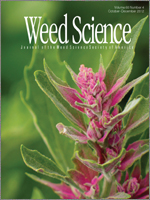Early physiological mechanisms that occur in crop plants in response to neighboring weeds are not well understood. In this experiment, it was hypothesized that, in the absence of direct competition for resources, low red to far red ratio (R∶FR) reflected from neighboring weeds will modulate the phenylpropanoid pathway, increase hydrogen peroxide (H2O2), and up-regulate the expression of ethylene biosynthesis and auxin transport genes. Laboratory experiments were conducted under conditions of nonlimiting resources using perennial ryegrass as a model weed species. We discovered that the detection by phytochrome (Phy) of low R∶FR signals reflected from both biological and nonbiological sources triggered an up-regulation of ethylene biosynthesis genes and stimulated an auxin transport gene. The low R∶FR also modulated the phenylpropanoid pathway resulting in a reduction in anthocyanin content and an enhancement of lignin synthesis. The presence of neighboring weeds also caused an accumulation of H2O2 in the first leaf and crown root tissues of the maize seedling. Stomata were observed to be closed as H2O2 accumulated in leaf tissue. This is the first study to report the modulation of phenylpropanoid pathway and the accumulation of H2O2 attributed to low R∶FR. We further suggest that these physiological changes that occur in response to early weed competition result in a physiological cost to the crop plant, which contributes to the rapid loss in yield observed in weed competition studies conducted under field conditions.
Nomenclature: Maize, Zea mays L., perennial ryegrass, Lolium perenne L., red to far-red, R∶FR, hydrogen peroxide, H2O2.





